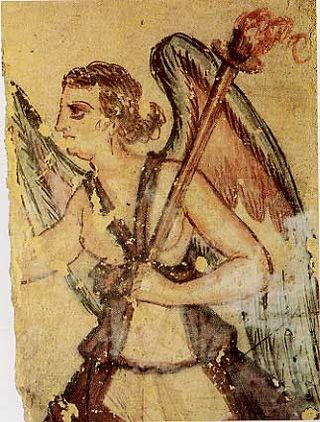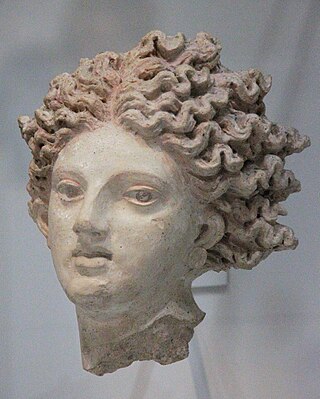Related Research Articles

Hades, in the ancient Greek religion and mythology, is the god of the dead and the king of the underworld, with which his name became synonymous. Hades was the eldest son of Cronus and Rhea, although this also made him the last son to be regurgitated by his father. He and his brothers, Zeus and Poseidon, defeated their father's generation of gods, the Titans, and claimed joint rulership over the cosmos. Hades received the underworld, Zeus the sky, and Poseidon the sea, with the solid earth available to all three concurrently. In artistic depictions, Hades is typically portrayed holding a bident and wearing his helm with Cerberus, the three-headed guard-dog of the underworld, standing at his side.

In ancient Greek mythology and religion, Persephone, also called Kore or Cora, is the daughter of Zeus and Demeter. She became the queen of the underworld after her abduction by her uncle Hades, the king of the underworld, who would later also take her into marriage.

In Greek mythology, Charon or Kharon is a psychopomp, the ferryman of the Greek underworld. He carries the souls of those who have been given funeral rites across the rivers Acheron and Styx, which separate the worlds of the living and the dead. Archaeology confirms that, in some burials, low-value coins were placed in, on, or near the mouth of the deceased, or next to the cremation urn containing their ashes. This has been taken to confirm that at least some aspects of Charon's mytheme are reflected in some Greek and Roman funeral practices, or else the coins function as a viaticum for the soul's journey. In Virgil's epic poem, Aeneid, the dead who could not pay the fee, and those who had received no funeral rites, had to wander the near shores of the Styx for one hundred years before they were allowed to cross the river. Charon also ferried the living mortals Heracles and Aeneas to the underworld and back again.

In Greek mythology, Ixion was king of the Lapiths, the most ancient tribe of Thessaly.

Etruscan religion comprises a set of stories, beliefs, and religious practices of the Etruscan civilization, heavily influenced by the mythology of ancient Greece, and sharing similarities with concurrent Roman mythology and religion. As the Etruscan civilization was gradually assimilated into the Roman Republic from the 4th century BC, the Etruscan religion and mythology were partially incorporated into ancient Roman culture, following the Roman tendency to absorb some of the local gods and customs of conquered lands. The first attestations of an Etruscan religion can be traced back to the Villanovan culture.

Februus is an ancient Italic god of purifications, who was worshipped by both the Romans and Etruscans. He was also worshipped as the god of the underworld by the Etruscans. For them, Februus was also the god of riches and death, both connected loosely to the underworld in the same natural manner as with the better-known Roman god Pluto. Februus' name could mean "the underground [one]" in the Etruscan language.

In Etruscan mythology and religion, Laran is the god of war. In art, he was portrayed as a naked youth wearing a helmet, a cuirass and carrying a spear, shield, or lance. Laran also appears to be an underworld god. Among his attributes is his responsibility to maintain peace. According to some scholars, he also seems to have been the guardian of boundaries as shown by the boundary cippi found in Bettona with the inscriptions tular Larna and tular larns. Along with eight other Etruscan gods, he can wield lightning. Due to the Tabula Capuana we know that the Laran festival was celebrated on the Ides of May. Laran is the Etruscan equivalent of the Greek Ares and the Roman Mars. Like many other Etruscan gods, his name is gender neutral.

Vanth is a chthonic figure in Etruscan mythology shown in a variety of forms of funerary art, such as in tomb paintings and on sarcophagi.

In Mesopotamian mythology, Ereshkigal was the goddess of Kur, the land of the dead or underworld in Sumerian mythology. In later myths, she was said to rule Irkalla alongside her husband Nergal. Sometimes her name is given as Irkalla, similar to the way the name Hades was used in Greek mythology for both the underworld and its ruler, and sometimes it is given as Ninkigal, lit. "Lady of the Great Earth".
In ancient Etruscan and Roman mythology, Mania, also spelled Manea, was a goddess of the dead, spirits and chaos: she was said to be the mother of ghosts, the undead, and other spirits of the night, as well as the Lares and the Manes. She, along with Mantus, ruled the underworld.

In Greek mythology, the Greek underworld, or Hades, is a distinct realm where an individual goes after death. The earliest idea of afterlife in Greek myth is that, at the moment of death, an individual's essence (psyche) is separated from the corpse and transported to the underworld. In early mythology the dead were indiscriminately grouped together and led a shadowy post-existence; however, in later mythology elements of post-mortem judgment began to emerge with good and bad people being separated.
The Infernal Names is a compiled list of adversarial or antihero figures from mythology intended for use in Satanic ritual. The following names are as listed in The Satanic Bible (1969), written by Church of Satan founder Anton Szandor LaVey. When calling the names, all of them may be recited, or a given number of those most significant to the respective working may be chosen. Not all were demons in their source culture; this list represents LaVey's interpretation of them and is presented below as they were written in the SatanicBible, and therefore is prone to historical errors and personal misconceptions.

The di inferi or dii inferi were a shadowy collective of ancient Roman deities associated with death and the underworld. The epithet inferi is also given to the mysterious Manes, a collective of ancestral spirits. The most likely origin of the word Manes is from manus or manis, meaning "good" or "kindly," which was a euphemistic way to speak of the inferi so as to avert their potential to harm or cause fear.

The mythologies in present-day Italy encompass the mythology of the Romans, Etruscans, and other peoples living in Italy, those ancient stories about divine or heroic beings that these particular cultures believed to be true and that often use supernatural events or characters to explain the nature of the universe and humanity.

Catha is a female Etruscan lunar or solar deity, who may also be connected to childbirth, and has a connection to the underworld. Catha is also the goddess of the south sanctuary at Pyrgi, Italy.
Manth, latinized as Mantus, is an epithet of the Etruscan chthonic fire god Śuri as god of the underworld; this name was primarily used in the Po Valley, as described by Servius, but a dedication to the god manθ from the Archaic period was found in a sanctuary in Pontecagnano, Southern Italy. His name is thought to be the origin of Mantua, the birthplace of Virgil.
References
- ↑ D. J. Conway, D. J. (1994). Maiden, mother, crone: the myth and reality of the triple goddess. Llewellyn Worldwide. p. 93. ISBN 0-87542-171-7.
- ↑ Wilkinson, Philip (2007). Mythology. Dorling Kindersley Ltd. p. 91. ISBN 978-1405334754.
